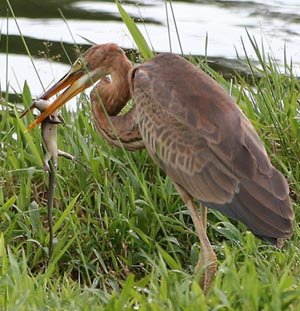Herons are carnivores, feeding on a wide range of live animals found within their aquatic environment. These may include fish, frogs, snakes, lizards, birds and small mammals. They also take aquatic insects and crustaceans.
The long neck and sharp pointed bill are well adapted to harpoon preys. The bird stands motionless in shallow water among vegetation until a prey approaches. It then suddenly seizes it with the bill or if large enough, impales it. An account on the baiting strategy of Little Heron (Butorides striatus) has been posted earlier.
Herons swallow their prey whole. They have an excellent digestive system that takes care of their food efficiently, leaving only bones, feathers, exoskeletons and fur that get regurgitated as pellets.
Adults feed their chicks by regurgitating the prey whole. The chick may swallow the food whole or if too large, the parent bird may break it up into smaller bits.
The image above, provided by Chan Yoke Meng, of a Purple Heron regurgitating a rat, tail-first (it cannot be otherwise) to feed the chick, was taken at Yong Peng, Malaysia in August 2005. Obviously the regurgitated rat needed to be repositioned before the chick can swallow it. Or did it swallow the rat tail first?
The image below by YK Chia shows another Purple Heron, this time a juvenile, with a lizard between its beak. If you look closely, you can see where the lizard had its body pierced.
Thanks to Chan Yoke Meng and YK Chia for the use of their images. Check out YK’s blog.










One Response